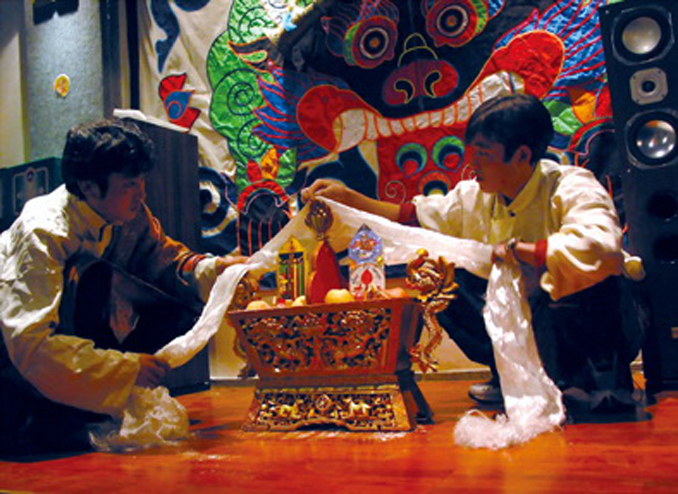Written by: Wei Liming
Posted on: October 15, 2013 |  | 中文
| 中文
Monks holding a prayer meeting to celebrate Tibetan New Year
Most Tibetans live in the Tibet Autonomous Region. There are also Tibetan communities in the Qinghai, Gansu, Sichuan and Yunnan provinces, where Tibet Autonomous Prefectures were established in the 1950’s and 1960’s.
The Tibetans originated from an agricultural tribe settling along the middle reaches of the Yarlung Zangbo River in Tibet. In the 7th century, King Songzan Gambo began to unite and rule the whole of the Tibetan areas and made "Losha" (today's Lhasa) the capital of his kingdom, which was called "Tubo," according to the Chinese historical documents of the Tang and Song dynasties.
The Yuan Dynasty founded by the Mongols in the 13th century officially brought Tibet under the unified rule of the central government by instituting the administrative system, deploying army troops, appointing civil and military officials, and fully exerting sovereign power in the region. This was the beginning of the Chinese central authorities' overall control of Tibet.
The Tibetans, with a population of 6.282 million, according to the sixth national census in 2010, have their own spoken and written language, which belongs to the Tibetan branch of the Tibeto-Burman group of the Sino-Tibetan language family. The Tibetan language has three major local dialects according to geographical divisions. The Tibetan script, an alphabetic system of writing, was created in the early 7th century and is used in all areas inhabited by Tibetans to this day.
The Tibetans believe in Lamaism, which belongs to the Mahayana School of Buddhism but have assimilated some of the beliefs and rites of the local religion called "Bon." Lamaseries are all over Tibet and many Tibetan festivals bear a strong mark of religion. The Tibetans' social life and customs and habits bear obvious marks of their historical traditions and distinctive culture up to date.
The Tibetans have their own calendar, which was systematized in 1027. Written records show that the Tibetans invented their own calendar before 100 BC, called the Bon Calendar. As the cultural exchanges between the Tibetans and the Han people increased, the Tibetan calendar finally became quite similar to the Lunar Calendar followed in areas home to members of the Han nationality. Under the rule of the Sagya Monastery, the Tibetan calendar became fixed, along with the ceremonies to celebrate the Tibetan New Year. It has remained unchanged since then.
 |
| The dedication of Qiema |
The Tibetan calendar designates years by use of the five elements (metal, wood, water, fire and earth) and the 12 animals, which represent the 12 Earthly Branches. A year is thus divided into four seasons and 12 months, which have 29 or 30 days. For example, the year 2009 is called the Year of Earth Ox and the year 2010 called the Year of Iron Tiger according to the Tibetan Calendar. Based on the Gregorian calendar, the Tibetan New Year is close to the Spring Festival of the Han people. In 2009, the Tibetan New Year was 10 days behind the Spring Festival.
The Tibetan New Year is the most important festival in Tibet. Tibetans begin preparing for New Year's Day early in the twelfth month of to the Tibetan calendar. Besides food preparations, each household has to get ready a Five-Cereal Container which is a richly-carved colorful wooden box containing fried highland barley mixed with butter, with flowers made of butter and green shoots of highland barley above. This is done to pray for a bumper harvest and better life in the coming year.
Moreover, in preparation, Tibetans put highland barley seeds in a bowl of fresh water so that they can grow into one-or-two-inch-long green shoots when the New Year arrives. They also make fried wheat dough mixed with butter in various shapes as religious offerings and also for visiting guests.
On the eve of the Tibetan New Year, Tibetans clean up their houses, change door and window curtains, set up brand-new prayer flags on the roof and paint patterns symbolizing eternity and good luck, on their gates with lime. In the evening, all the family members get together and an "auspicious dinner" is offered. The main meal of the dinner is dough drops known as Guru in Tibetan, inside which stone, wool, hot pepper, charcoal or coins are placed. These items are said to be able to foretell the nature of and future fortunes of the person who eats each of them. For example, stone implies a cruel heart, wool stands for a soft heart, charcoal for a black heart, hot pepper for tough talking and coins for good fortune.
The Tibetan people usually don't go out or visit each other on the first day of the Tibetan New Year. From the second day onwards, they dress in their holiday best and extend greetings with the auspicious words, "tashi delek," and present Hada to each other. Mass singing and dancing, as well as traditional Tibetan operas, are performed in towns and villages across Tibet during the period. On the 15th day, religious activities are held in large parts of the Tibetan areas.
You may also like: